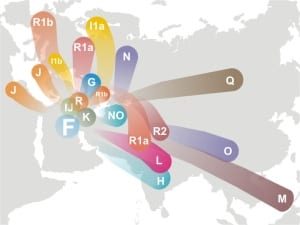
Science is dynamic and ever changing. As new research is published, theories get revised, and hypotheses retested. The field of genetic ancestry is no exception: The flurry of published research just in the last five years has been staggering, and we can now piece together the histories of many groups from nearly all parts of the globe. At the same time, a worldwide community of genealogists has seized upon this wealth of published research, combining it with their own genetic data to produce an even richer, more detailed human history.
We want our customers to have the most current information possible, so our scientists and engineers have spent the last several months updating the paternal lineages, or haplogroups, for all of our (male) customers. This has been quite a task, involving many layers of analysis and quality control to meet our standards of precision and accuracy. The end result is a more detailed understanding of paternal ancestry for our customers.
The New Tree
Customers can find the 23andMe paternal haplogroup tree on the paternal line feature page. It lays out the specific haplogroups for populations around the world, how they are related to each other, and how all men alive today can trace their paternal ancestry back to one individual who we refer to as the PoP (Poppa of all Poppas). The organization of this tree is derived from more than 2,000 variable genetic markers, known as SNPs, on the Y chromosome. The particular combination of SNPs a man has determines which haplogroup his Y chromosome belongs to.
Finding the Right Tree
Over time enough additional SNPs are discovered, and there are enough revisions to the organization of other researchers’ Y haplogroup trees, that we must give our own a face lift to keep up. We used a variety of sources as a basis as we developed our new paternal haplogroup tree. We examined the published literature and spoke with experts in the field of Y chromosome genetic ancestry. Perhaps most importantly, we used the wealth of information gathered from the International Society of Genetic Genealogy (also known as ISOGG). This non-profit organization is run by genealogy enthusiasts who are passionate about discovering their family history through genetics. These enthusiasts, many of them 23andMe customers, have sifted through mounds of genetic data, both from the published literature and their own genetic profiles. The fruits of their labor are collected and organized in a haplogroup tree that is regularly updated at a high level of detail. ISOGG exists and prospers because so many genealogists are working together for a common goal.
We have worked primarily with the December 2008 ISOGG paternal haplogroup tree as a basis for updating our own. Even since then, some paternal haplogroups been updated significantly. So for these rapidly evolving haplogroups, we used the May 2009 ISOGG paternal haplogroup tree as a reference. The end result is a very detailed and up-to-date paternal haplogroup assignment for each of our male customers.
Your Paternal Haplogroup
What does this update mean for our customers? For many it means a change in their haplogroup assignment. That change may be slight, or it may be more substantial. For other customers it means no change at all. When examining your new paternal haplogroup, it is likely you will see one of the following differences:
1) A more specific assignment: Because the new paternal haplogroup tree examines many more SNPs than the original, we are able to give our customers more precise assignments. As a result, it is possible that your new haplogroup assignment may be longer and more specific than the original. For example, customers who were assigned haplogroup J2a1 will now be reassigned to haplogroup J2a1a.
2) A more specific and slightly different assignment: This category of change is by far the most common affecting our customers, because the organization of the haplogroup tree has changed. Therefore someone’s new assignment may look similar to their old one, but it will be longer and/or slightly different. For example, a customer who was assigned to R1b1c may now be reassigned to R1b1b2.
3) A completely new letter assignment: This is the rarest of the changes that will likely occur, and is also due to a reorganization of the paternal haplogroup tree over the past few years. For example a customer currently classified as K2 will now be reassigned to haplogroup T.
It is important to note that your ancestry has not changed. It’s only your haplogroup assignment that’s changed. This update has allowed us to define many more haplogroups than we had originally. This means we can give even more specific information about our customers’ paternal ancestry. We will continue to update the summary pages for our haplogroups with this additional genetic history.



